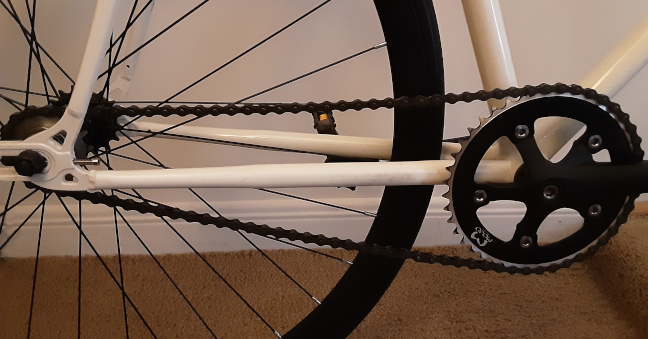
All product names, logos, and brands used in this post are property of their respective owners.
I recently picked up the least weird of my weird bikes - an economical 6KU fixie! I have always been intrigued by the simplicity and minimalism of fixed-gear bicycles. Not to mention the cardio benefits.
Thus far, the bike has been solid and a blast to ride. My only issue is a self-inflicted one. My subpar cycling fitness makes pushing the bike’s stock 76 gear inches (6 meters of development) uphill or against the wind very challenging. That is a lot of gear inches (in my opinion)!
I’m sure this guy would have no issue with the 46/16 factory gearing:

Image by Monster.com. Extracted from a Monster.com's clever "There's a perfect job for everyone" commercial, aired circa 2008.
To that end, I wanted a quick and easy way to reduce the gear ratio and make the bike more manageable on climbs. Perhaps the more “natural” option would have been replacing the rear sprocket (increasing from 16T to something with more teeth). That would have required tools and skills I do not have, so I ended up replacing the chainring instead. The bike uses a relatively standard 110 mm BCD (bolt circle diameter) with five arms. I used Sheldon Brown’s Bicycle Gear Calculator to estimate the impact of swapping the chainring for a smaller one (fewer teeth). On the 6KU fixie, each decrement of 2 teeth results in a 4-5% reduction in pedaling effort (gear inches/meters of development).
The swap was painless, and most importantly, possible to complete with the tools I have on hand (5mm hex wrench and chain tool). It was a matter of removing the five bolts that attach the chainring to the crankset, mounting the new chainring, popping a pin on a chain link, and reconnecting the chain with the master link.

I dropped from a 46T chainring to a 38T one for around a 20% reduction in gearing (62 vs. 76 gear inches). It makes a noticeable difference on climbs and against headwinds. My quadriceps and hamstrings think so anyway. Additionally, the 38/16 gear ratio does not compromise the bike’s performance on flats (much), since I have a high RPM cadence (which I could not sustain with the original gearing anyway). Reducing the chainring size by eight teeth required removing four links from the bike’s 1/8" chain (hence the need for a chain tool).
All in all, this was a relatively cheap, quick, and worthwhile fix for my pedaling woes on the 6KU fixed gear bicycle.